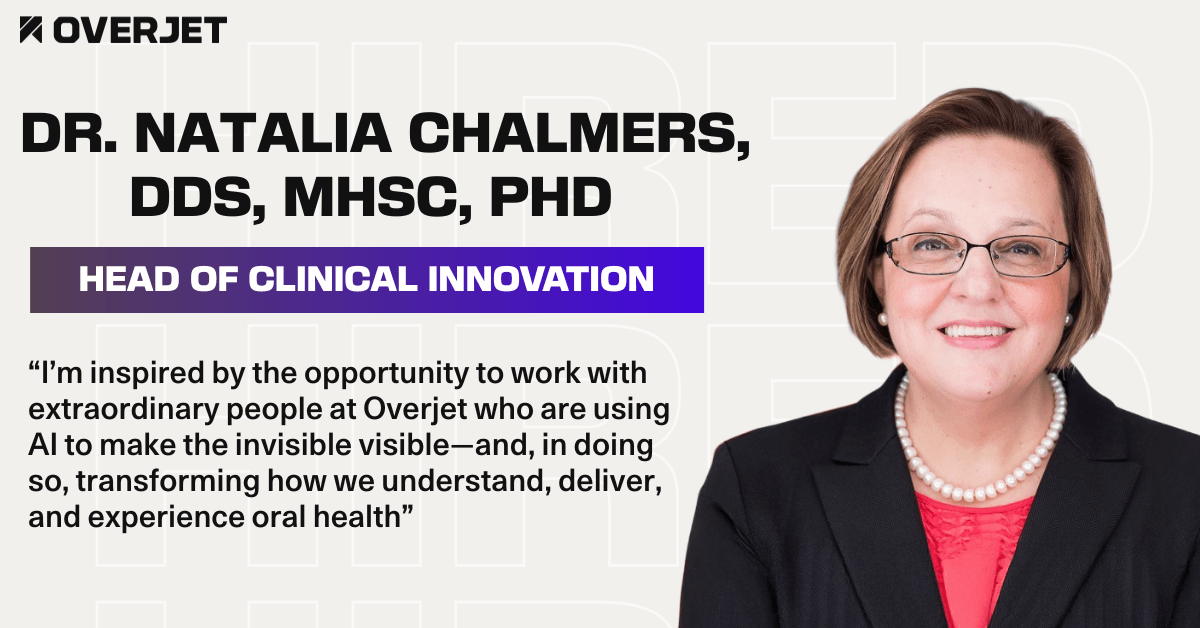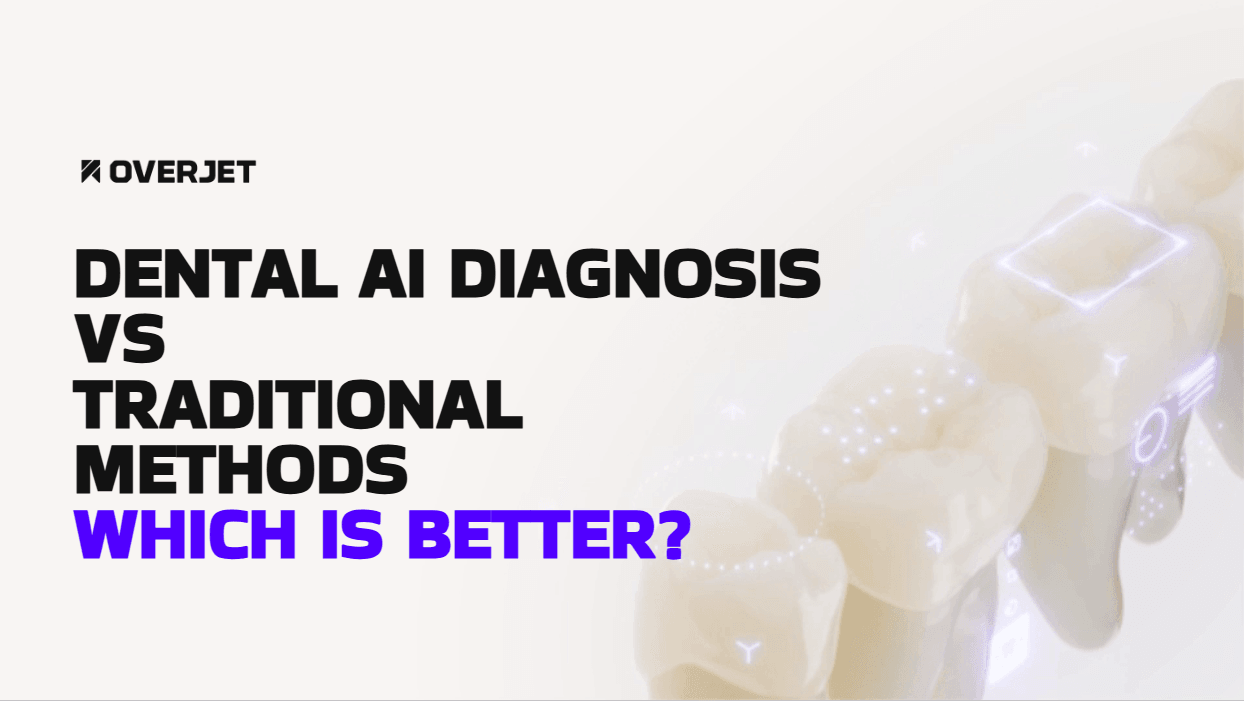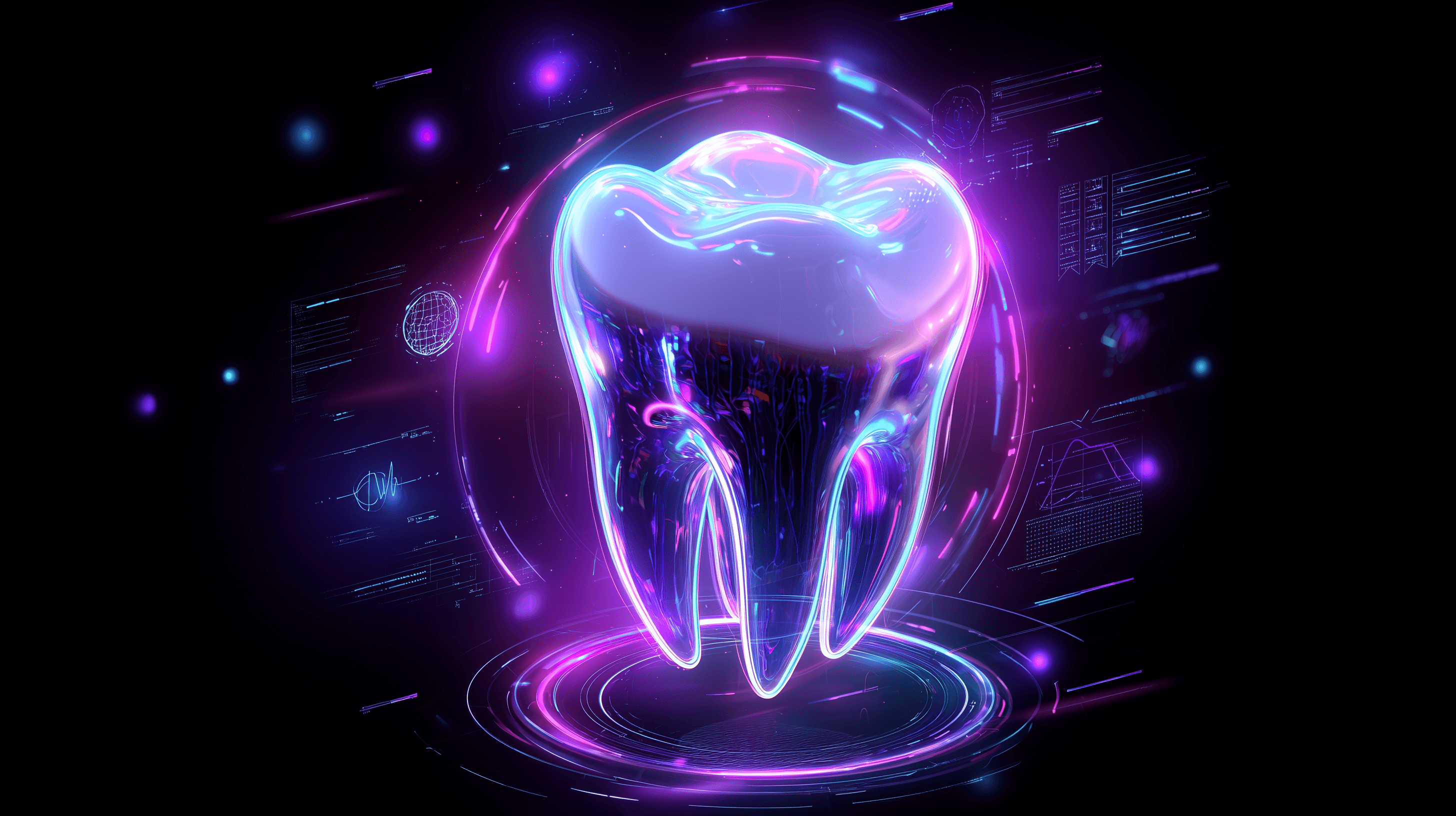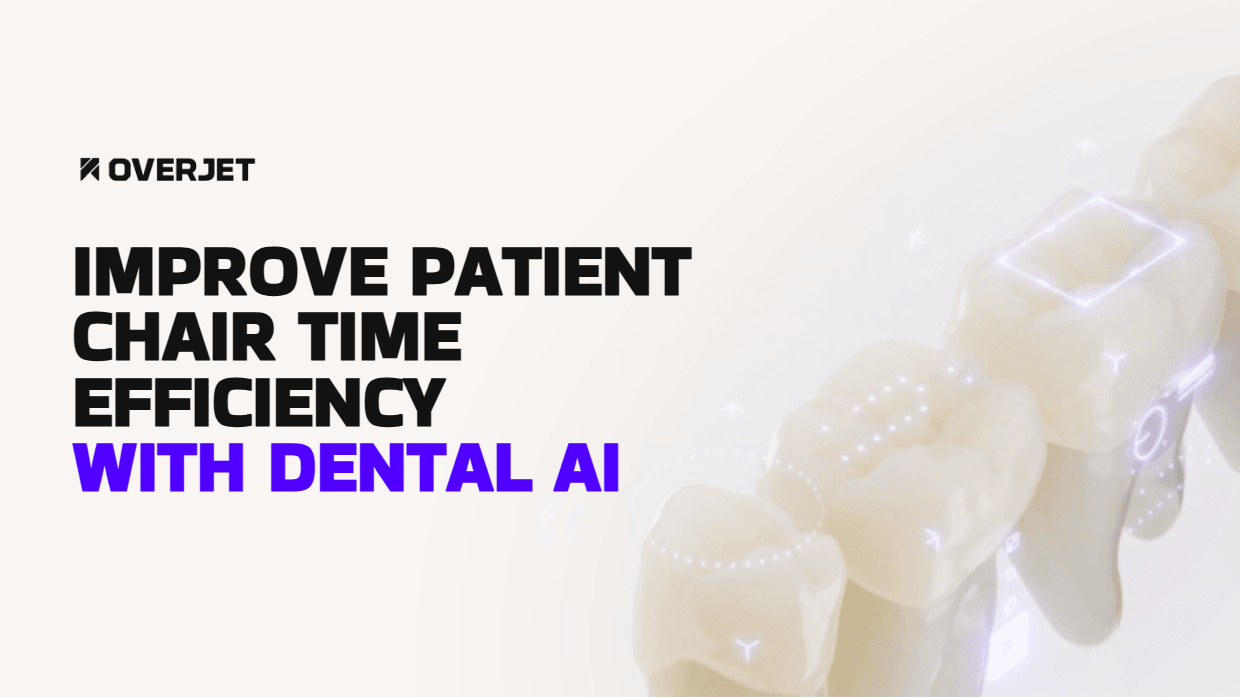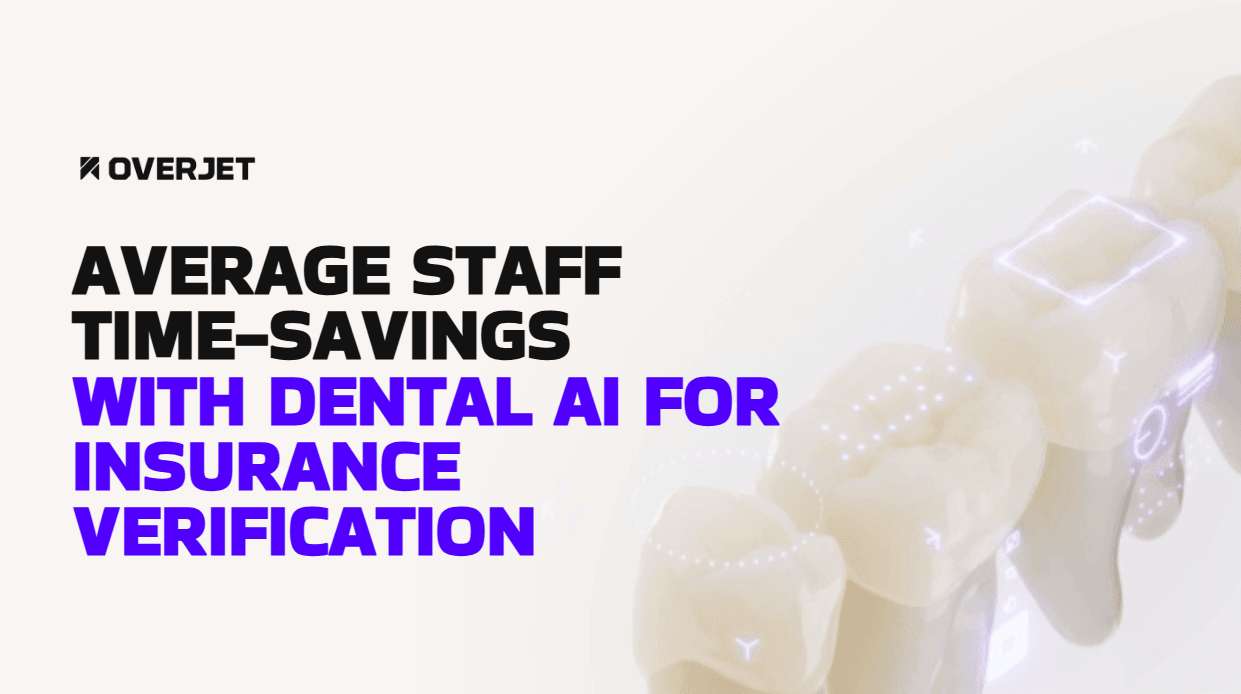Impact on Patient Care, Education, and Workflow Efficiency
Dental practices face a critical decision when evaluating AI technology: will it actually save time, or will it create another layer of tasks for already-busy clinical teams? The answer depends on implementation approach, vendor selection, and how well the technology integrates into existing workflows.
This guide examines real efficiency gains AI delivers in diagnostic speed, insurance automation, and patient communication, while addressing legitimate concerns about training time, image quality requirements, and system maintenance. You’ll learn which metrics matter for measuring ROI, how to avoid common implementation pitfalls, and what separates AI platforms that genuinely reduce workload from those that simply shift tasks around.
Explore Overjet's Dental AI Software
Current State of Dental AI Adoption
Dental AI has moved from experimental technology to operational reality in practices nationwide. The software automates repetitive tasks like insurance documentation while helping clinicians spot pathology on radiographs faster than manual review alone. Implementation does require some upfront training time, though the goal remains a more streamlined workflow rather than added burden.
Growth Trends in Practices and DSOs
Larger dental organizations have adopted AI first, largely because they already have infrastructure for rolling out new technology across multiple locations. Multi-site practices benefit from AI’s ability to standardize diagnosis and treatment planning across different providers. Solo practitioners are starting to follow as platforms become easier to integrate with existing practice management systems.
Most Common Use Cases Today
Three areas dominate current AI applications in dentistry. First, diagnostic imaging analysis helps detect caries, calculus, and bone loss on radiographs with precision down to individual pixels. Second, treatment planning tools analyze patient records to identify care opportunities that might otherwise go unnoticed. Third, administrative automation handles insurance verification and claim narrative generation without staff intervention.
Overjet’s FDA-cleared platform addresses all three categories, giving practices a single solution rather than requiring multiple software subscriptions is the first and only dental AI platform FDA-cleared specifically for enhancing dental images.
Measurable Efficiency Wins Across Clinical and Administrative Workflows
Chair-Side Diagnostic Support
AI highlights potential pathology on radiographic images while the patient sits in the chair. Overjet’s software marks early-stage caries and periodontal disease with colored annotations, allowing clinicians to make decisions faster without squinting at subtle gray-scale variations. The visual overlays double as patient education tools, eliminating the extra step of pulling up stock images to explain what decay or bone loss looks like.
Automated Claim Review and Narratives
Writing clinical narratives for insurance claims traditionally eats up hours each week. Staff members review radiographs, translate findings into payer-friendly language, and respond to requests for additional documentation when claims get flagged. AI platforms like Overjet generate detailed narratives automatically based on radiographic findings and procedure codes. Practices reportMany practices observe fewer claim denials because AI-generated documentation consistently meets payer requirements, cutting down on the back-and-forth that delays payment.
Reduced Hygiene Appointment Length
Hygienists using AI diagnostic tools locate calculus deposits and interproximal caries more quickly during initial patient assessments. The technology doesn’t replace clinical judgment, it speeds up the detection process so hygienists spend less time scrutinizing images and more time discussing findings with patients. Some practices maintain the same appointment quality while fitting in additional patients each day.
Hidden Tasks and Potential Burdens to Watch For
Training Time for Clinical Teams
Any new software comes with a learning curve. Staff members typically need two to four weeks of regular use to feel comfortable with diagnostic interpretation and workflow integration. Quality platforms minimize this adjustment period through intuitive interfaces and hands-on onboarding support. Overjet provides dedicated training sessions for each role in the practice, from front desk staff handling insurance automation to hygienists reviewing diagnostic annotations.
Image Quality and Retake Rates
AI systems rely on high-quality radiographic images to function accurately. Poor positioning, motion blur, or exposure problems compromise diagnostic precision just as they would for human interpretation. Some practices initially see higher retake rates as staff adjust their imaging technique to meet quality standards. However, this temporary increase often reveals existing quality issues that were going unnoticed, ultimately raising radiographic standards across the practice.
Data Entry and System Maintenance
AI automates many tasks but doesn’t eliminate human oversight entirely. Clinicians review AI-generated findings before finalizing treatment plans, and someone monitors system performance to catch integration hiccups with practice management software. Most practices find this oversight takes minutes per day rather than hours, representing minimal additional work compared to the time saved through automation.
How AI Impacts Patient Communication and Case Acceptance
Visual Explanations That Build Trust
Patients grasp their oral health better when they see annotated radiographs showing exactly where problems exist. Overjet’s detection capabilities highlight decay, bone loss, and other conditions with colored overlays that make abstract clinical findings concrete. This visual clarity reduces patient skepticism and cuts down on lengthy verbal explanations, as the images demonstrate the problem directly.
Consistency in Diagnostic Language
AI ensures every team member uses the same terminology when discussing patient conditions. The hygienist who first reviews radiographs and the dentist who presents treatment options both reference the same standardized findings. This consistency eliminates confusion that can arise when different team members describe conditions differently. Practices using Overjet report case acceptance increases, driven by clearer communication and more compelling visual evidence.
Data Accuracy, FDA Clearance and Compliance Essentials
Importance of Pixel-Level Annotation Precision
Diagnostic accuracy varies significantly across AI vendors depending on how algorithms were trained and validated. Pixel-level annotation means the software identifies exact boundaries of pathology rather than just flagging general areas where something might be wrong. This precision provides clinically actionable information that dentists can trust when making treatment decisions. Overjet’s algorithms achieve FDA clearance through demonstrated accuracy against expert clinician assessments across multiple diagnostic applications.
HIPAA and PHI Safeguards
Patient data security remains critical when implementing digital health technology. Reputable AI platforms maintain HIPAA-compliant infrastructure with encryption and access controls that protect patient information without requiring practices to manage complex security protocols. Overjet handles compliance requirements at the platform level, so practices gain AI capabilities without assuming additional regulatory responsibility.
KPIs to Track ROI From Day One
Diagnostic Accuracy Uplift
Measuring diagnostic consistency before and after AI implementation reveals the technology’s clinical impact. Track the percentage of radiographic findings confirmed during clinical examination compared to historical baselines. Also monitor early-stage pathology detection rates to see whether AI genuinely enhances diagnostic capabilities or simply adds another information layer without improving outcomes.
Claim Approval Percentage
Monitor first-pass claim acceptance rates and how often payers request additional documentation. Practices using AI-generated clinical narratives typically see approval rates climb within the first quarter of implementation. Fewer claim denials translate directly to faster payment cycles and less administrative time spent on appeals and resubmissions.
Production Per Operatory Hour
Calculate patient throughput by measuring procedures completed per clinical hour. AI’s diagnostic speed and patient education capabilities often allow practices to maintain care quality while seeing more patients weekly. This metric captures true efficiency gain, not just faster workflows, but higher productivity without compromising clinical standards.
Metric | Before AI | After AI |
Diagnostic time per radiograph | 3-4 minutes [Results may vary] | 1-2 minutes [Results may vary] |
Claim approval rate | 70-75% [Results may vary] | 85-90% [Results may vary] |
Patient case acceptance | 25-30% [Results may vary] | 35-40% [Results may vary] |
Hygiene appointments per day | 8-10 [Results may vary] | 9-12 [Results may vary] |
Step-By-Step Roadmap for Successful Implementation
1. Define Success Metrics
Establish baseline measurements for diagnostic time, claim approval rates, and patient acceptance before introducing AI. Clear pre-implementation data allows you to quantify efficiency gains and identify where the technology delivers the most value. Without baselines, you’re left with subjective impressions rather than objective evidence.
2. Select Pilot Locations
Start implementation at locations with engaged teams and strong existing workflows. Success in pilot sites builds organizational confidence and generates internal champions who can support broader rollout. Avoid launching AI at struggling locations where multiple operational challenges might obscure the technology’s actual impact.
3. Train and Certify Teams
Comprehensive education on AI capabilities and limitations ensures teams understand both what the technology can do and where clinical judgment remains essential. Overjet provides role-specific training for dentists, hygienists, and administrative staff, addressing how each team member interacts with the platform. Certification processes confirm proficiency before full deployment.
4. Integrate With PMS and Imaging
Technical setup varies depending on existing practice management systems and imaging hardware, though modern AI platforms connect with most major software. Prioritize vendors who offer dedicated implementation support and troubleshoot integration issues quickly. Overjet’s technical team handles the entire integration process, minimizing IT burden on practice staff.
5. Review Data and Iterate
Regular assessment of performance metrics allows you to optimize AI settings and refine workflows based on real-world usage patterns. Monthly reviews during the first quarter identify friction points and training gaps that might slow adoption. This iterative approach helps AI become a natural part of daily operations rather than a parallel system teams work around.
Choosing the Right Vendor and Avoiding Common Pitfalls
Validation Studies and Peer Review
Clinical evidence separates proven AI platforms from unvalidated software that might compromise diagnostic accuracy. Look for peer-reviewed publications demonstrating performance against expert clinician assessments and FDA clearance for specific diagnostic applications. Overjet’s algorithms have been validated across diverse patient populations and practice settings, ensuring reliability regardless of patient demographics or imaging equipment.
Support and Onboarding Resources
Quality vendors provide comprehensive training, responsive technical support, and ongoing clinical education to maximize platform value. Evaluate the depth of onboarding programs and availability of support resources before committing to a platform. Inadequate vendor support transforms potentially helpful technology into an operational burden that frustrates staff.
Total Cost of Ownership
Consider all implementation costs including training time, system integration, and ongoing support beyond initial software licensing fees. Some platforms require expensive hardware upgrades or charge separately for technical support and software updates. Transparent pricing models that include comprehensive support and work with existing imaging systems eliminate hidden costs that erode return on investment.
Key vendor evaluation criteria:
Clinical validation: Peer-reviewed studies and FDA clearance for diagnostic applications
Integration capabilities: Seamless connection with existing practice management and imaging systems
Support quality: Comprehensive training programs and responsive technical assistance
Pricing transparency: Clear total cost without hidden fees or required hardware upgrades
Transforming Dental Care Through Balanced AI Adoption
Well-implemented dental AI creates substantial efficiency gains despite requiring initial training investment and workflow adjustments. Success depends on selecting proven platforms that minimize implementation burden through intuitive design, comprehensive support, and seamless integration with existing systems. Practices that approach AI adoption strategically, defining clear success metrics, training teams thoroughly, and partnering with validated vendors, consistently report net productivity improvements within three to six months.
The efficiency versus burden question ultimately depends on execution rather than the technology itself. AI platforms that enhance clinical judgment, automate genuinely time-consuming tasks, and provide measurable diagnostic value deliver the promised efficiency gains. Platforms that add complexity without clear clinical or operational benefits create the additional work many practices fear.
Ready to see how Overjet streamlines practice workflows without adding complexity?
Ready to See Overjet's Dental AI in Action?
Frequently Asked Questions (FAQs)
How long does it take for dental staff to become proficient with AI diagnostic software?
Most clinical teams achieve basic proficiency within two to four weeks of regular use, with full integration into daily workflows typically occurring within two months of implementation. Proficiency timelines vary based on team size, existing technical comfort, and the quality of vendor training programs.
Does dental AI require new hardware or upgrades to existing imaging sensors?
Quality AI platforms work with existing digital radiography equipment and practice management systems, requiring minimal hardware changes for most modern dental offices. Overjet integrates with all major imaging systems and PMS platforms, eliminating the need for expensive equipment upgrades.
Can we limit AI access so only dentists see diagnostic probability scores?
Yes, professional AI platforms offer role-based permissions allowing practices to control which team members view specific AI outputs and recommendations. This flexibility ensures appropriate oversight while still allowing hygienists and assistants to benefit from AI-enhanced workflows within their scope of practice.
What happens if the AI diagnostic output conflicts with my clinical judgment?
AI serves as a diagnostic aid rather than a replacement for clinical expertise, so dentists maintain full authority over treatment decisions and can override or ignore AI recommendations when appropriate. The technology enhances clinical decision-making by highlighting potential findings that warrant closer examination, but final diagnostic and treatment decisions always rest with the licensed provider.




